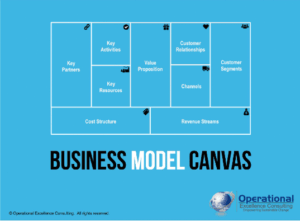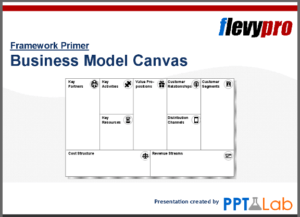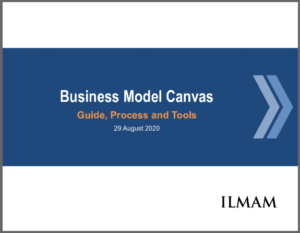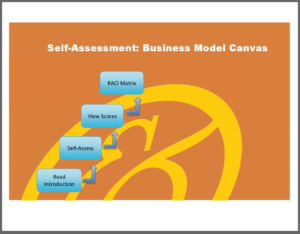The Customer Segments component of the business model canvas is the first component. It drives choices made in all the other components, and thus drives choice of a business model.
This post explores Customer segments, how it fits into the business model canvas, and how this strategic choice also drives projects.
Perspective on Customer Segments in the Business Model Canvas
Identifying a Customer Segment is the first step in developing a business model using the Business Model Canvas.
The Business Model Framework is largely credited to Alexander Osterwalder and Strategyzer. To supercharge your understanding of business models, I recommend his book, “Business Model Generation: A Handbook for Visionaries, Game Changers, and Challengers”.
Choosing a Customer Segment is a highly strategic decision and is supported by many other strategic frameworks. Here are a few to consider:
- Porter’s three generic strategies – Porter identifies three basic choices: cost leadership, differentiation, or a unique focus driven by either cost or differentiation considerations.
- Ansoff Matrix Model – This approach entails use of a quad chart to visualize strategic options based upon choices characterized by new vs existing markets, and new vs existing products.
- Porter’s Five Forces – The structure of the industry will have a profound effect on choice of target customer segment. Consider competitive forces, competitive risks associated with different approaches, and where your company fits.
- Stage of Business and Industry Growth – Identify your company’s maturity level. Is it a startup or growth company, or more mature? Where does it want to go with this particular venture?
- The Experience Curve – Consider your company’s level of experience with the business and customers of a potential target segment. What is likely to happen in terms of experience if you target a certain customer segment?
Choosing a Customer Segment is identified as the first step in the business model canvas because it drives so many other steps, such as creating the value proposition. As a result, it often makes sense to use a separate business model canvas – and unique business model – for each Customer Segment.
How to Go About Segmenting Customers
There are many ways to segment a market. Some more common ways include:
—————————————-
I recommend these strategy resources on FlevyPro (paid links):
| Business Model Canvas 140-slide PowerPoint deck and supporting PDF  |
| Business Model Canvas 22-slide PowerPoint deck  |
| Business Model Canvas: Guide, Process and Tools 43-slide PowerPoint deck  |
| Business Model Canvas – Implementation Toolkit Excel workbook and supporting ZIP  |
—————————————-
- Demographic – What is the makeup of the target segment in terms of gender, income, education, relationship status and many other statistical considerations?
- Geographic – Where are the customers located? What physical, cultural, and accessibility attributes are important to note?
- Psychographic – What interests, opinions, beliefs, values, and political views do the target segment customers have?
- Jobs To Be Done – Can your product or service get the job done for them? Or can it augment their solution, put you in partnerships with them, or somehow lessen the burden to them of getting the job done?
- Pains – What undesired outcomes or problems is the customer trying to avoid? What are the customer’s risks and barriers in this area? How severe is the pain, and how can it be lessened?
- Budget – How much can certain groups of customers pay for a solution?
- Reach – What customers can be reached by your company’s solution most easily? This could relate to direct personal contact, advertising, social media, or other means of messaging.
- Market size – How large is the potential target segment of customers? How dominant can you be in that segment?
- Value – What is the value that your product r service can provide in this segment? Some customer segments might see more value than others.
Segmenting customers in this way is helpful, but it is most important to be able to identify customers by their job to be done and the customer experience that they want and need. Design thinking is a particularly helpful approach to getting intimate with customer needs and preferences.
Definitions of Common Customer Segment Types
There are five commonly cited segment types that cover most situations. Here they are:
- Mass Market – Focus on mass markets is the broadest of all segment types. Target customers fit into a very broad grouping based upon a very generalized need. Many consumer products, such as refrigerators, luggage, electronics, and food fit into the Mass Market segment type. Note that it is possible to segment these broad markets, which brings us the second type.
- Segmented – This type identifies slight differences in customer needs in the Mass Market. It identifies some unique needs and differences within the Mass Market that could be better served with additional segmentation. Each Segmented customer profile will logically have a different, more specifically tailored, value proposition and overall business model.
- Diversified – This segment type most often occurs when the organization has some established underlying capabilities that can serve unrelated target customers. For example, a chocolate shop might serve retail consumers, but also prepare large gift arrangements of specialized packages for corporate customers. And Amazon sells books and other consumer products to individual customers, but provides web infrastructure to businesses.
- Niche Market – Often companies, especially startups and small companies, focus their efforts on a very narrow segment of customers with very specific needs. This potentially can result in a relatively small number of customers, such as a situation where a small or medium business is supplying large manufacturers in steel, chemicals, or automobiles.
- Multi-sided platforms – A more complex segment type relates to a platform that interfaces with several types of customers. One example is credit cards, which need to appeal to merchants as well as consumers. Another example is any situation where products and services are offered for free, and revenue is generated through advertising.
Smaller and startup businesses almost exclusively focus on one of these approaches, but not the Mass Market, as it is more difficult to manage with multiple approaches. Also, building and growing a business with one approach, such as the Niche Market or Segmented approaches, can be a good way to start and gain traction. Growth can come later by extending to Mass Market segments.
Approaches to Projects for Various Types of Companies
Your approach to projects will vary, depending on whether the company is a startup, or is a small, medium, and large business. In all cases, the market segment(s) the company serves are key strategic drivers of projects.
—————————————-
I recommend these PM templates (paid link):

—————————————-
Projects will vary widely, depending upon the type of company. Companies of these difference sizes and stages of maturity will have very different cultures. This will influence their approach to projects.
- Startup – A startup will focus on just one Customer Segment. The focus of projects – and the whole company – may initially be one project. Activities will include establishing relationships with target customers, establishing itself in the customer segment, and pivoting as much as needed in search of the best business model. This means following a lean innovation process in search of the right offering to serve the chosen customer segment.
- Small – Small companies will likely be targeting a Niche Market. Projects should be in alignment with that approach; project managers will need to tie the purpose of the project back to the Niche Market as a strategic driver. Cost, schedule, and quality all need to be aligned with the business model and the direct or indirect needs of the niche customer.
- Medium – With greater size, the selection of customer segment can include almost any of the segment types. Planning of projects needs to align the supporting business model and customer segment. Projects could support a Mass Market strategy, but that may pose a major risk in a highly competitive industry. Projects need to be right-sized to fit the scale of the company and industry, and to support the business model.
- Large – Like medium-size companies, large companies can also implement almost any type of customer segmentation. However, a large company may need to steer away from niche segments, unless there is a mass customization advantage. Again, the project portfolio and individual projects need to have an overall alignment with a business model that is likely to emphasize economies of scope and scale.

Project planning in the case of all sizes and shapes of companies needs to be aligned with the business model, which is first driven by choice of customer segment(s). Cost, scope, schedule, and quality all need to be prioritized and aligned with those choices.
You can quickly and conveniently work through the Customer Segments and other components of the Business Model Canvas with the Lucidchart Business Model Canvas template (Tryfor free) – recommended!
Conclusion and Further Resources
When devising a business model, focus on identifying the target Customer Segment(s) first. That choice drives all other choices, especially the value proposition.
When executing projects in various sizes of businesses, be cognizant of the Customer Segments that the business serves and make sure all projects and planning align with that strategic choice.
Please share any thoughts about your experience planning projects around Customer Segments.
To supercharge your understanding of business models, I recommend “Business Model Generation: A Handbook for Visionaries, Game Changers, and Challengers” by Alexander Osterwalder.
To learn more, I recommend viewing the following 9 minute video, entitled “Business Model Canvas Customer Segmentation Deep Dive” by Deep Journey:


